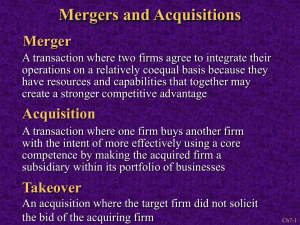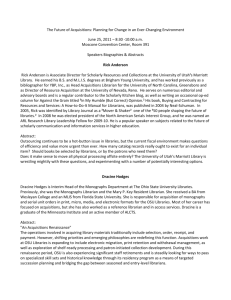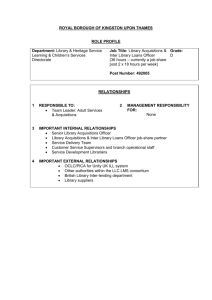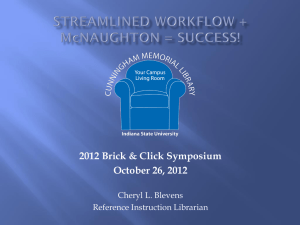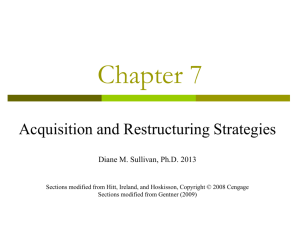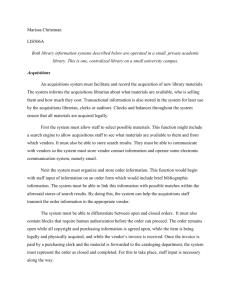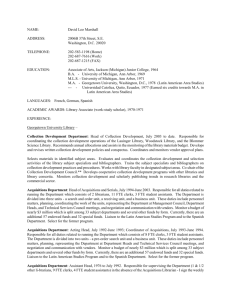Making Overseas Acquisitions Work
advertisement
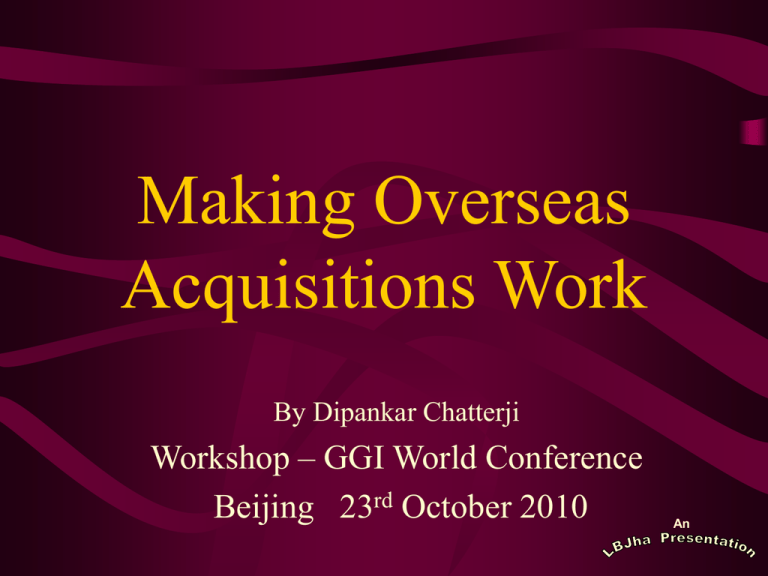
Making Overseas Acquisitions Work By Dipankar Chatterji Workshop – GGI World Conference Beijing 23rd October 2010 An • THE GLOBAL TAKEOVER SCENE • WHY ACQUIRE ? • ACQUISITIONS THAT DIDN’T WORK • LEARNING FROM FAILURES • MANAGING ACQUISITIONS – THE RIGHT WAY An THE GLOBAL TAKEOVER SCENE An Even post meltdown the global appetite for takeovers continue to grow DEAL MATRIX 9-month 2010 9-month 2009 Country Value No. of Deals Value No of Deals US 615.0 7603 574.2 5341 UK 140.1 1831 108.8 1844 China 137.4 2807 120.6 2339 Brazil 121.9 379 49.6 210 Canada 116.5 1490 59.6 1031 Japan 81.5 1925 97.2 2356 Australia 75.3 1174 109.5 1243 Spain 66.4 846 45.8 645 France 64.7 1191 54.2 954 India 56.7 948 17.4 747 Total 2033.9 30763 16674 27334 Value in $ Billion An • In 2009 globally 5800 companies involved in acquisitions valued at over $2.3 trillion • Many invidual deals are valued over the billion Dollar mark • Many domestic mergers in the same country end up being cross border acquisitions – Sandoz acquired Ciba Geigy – integration of operations across the globe – Many other examples An WHY ACQUIRE ? An Acquisitions driven by desire for• Topline growth • Increased market share • Eliminating competition • Balancing product portfolio • Moving upstream or down stream in supply chain • Acquiring technology – CISCO built its technological base through acquisitions • Acquiring distressed assets Overall objective of shareholders value creation An ACQUISITIONS THAT DIDN’T WORK An • A reality check of global cross border acquisitions reveals that most of them destroy value. • Some studies have put the failure rate at between 40% to 80%. The Mckinsey estimates show 61% failure rate. • The School of Business at Loyola College Chicago studied 6824 cross border acquisitions during 1985 – 2005 by buyers from 75 countries and targets in 128 countries. The study revealed that the majority of them destroyed value – $187 billion of acquirer shareholder wealth was destroyed in three days around the announcements of acquisitions. An • A study of 89 acquisitions of American companies by foreign buyers between 1977 and 1990 showed that most of them did not improve operational performance one year after acquisition(Source: Financial Times). • Many examples– Acquisition of Columbia Pictures by Sony. After paying a significant premium for the company, Sony was forced to take a $3.2 billion write down in 1994. An – After the HP-Compaq merger announcement the share prices of the two companies declined by 21.5% and 15.7%.Combined loss in market capitalization was $13 billion and the share price of HP continued to fall. – Ben Q acquired the mobile devices division of Siemens & went bankrupt after a year of heavy losses. An – AT & T acquired NCR and lost billions of dollars. – Many other examples, in the auto industry. The jury is still out on Tata’s acquisition of Land Rover & Jaguar and Zhejian Geely Holding Group’s acquisition of Volvo. An Why did so many cross border acquisitions fail? Many reasons • Wrong selection of target – Why are we a better parent for the company than someone else? – Will we be able to create more value by being more competitive, having a stronger cost structure, gaining additional competitiveness? – When will this value be realized? An • Lack of attention to cultural factors during due diligence. – Errors during due diligence are rarely technical. In many cases people fail to pay attention to cultural factors. According to GE this is the reason for failure in three out of 5 cases. • Lack of compelling strategic reason for acquisitions. Many companies should not be acquiring at all. A company with difficulties of its own is unlikely to be helped by acquisition. You do not acquire your way out of trouble. Also corporate “glory” cannot be a motive for acquisition. An • Flawed understanding of the new business. – Very often commercial due diligence does not identify black holes.Cross border acquisitions have failed because of unfamiliar accounting rules,different disclosure practices and legal systems with different attitudes towards property rights • Unrealistic expectations or excessive valuation – Deals should not be unstoppable.There must be a walkaway price. Very often competitive bidding sends prices beyond original valuations and the acquirer must know whether at such prices expectations will be realized. An • Flawed integration management – Most cross border acquisitions involve insufficient integration efforts.Bridgestone acquired Firestone in 1988 – but no real integration effort for five years. Senior Firestone management was left in place, no cost savings were generated and total losses amounted to $ 1 billion by 1992 – Employee stress and uncertainty post acquisition is also caused by poor integration efforts.Merger creates uncertainty and best people leave. Firestone workers ended up in a strike in 1994-95 driven by Bridgestone’s cost cutting efforts.Nestle had similar problems with acquisition of Rowntree in UK. An • Lack of shared vision – It is quite common for the acquirer company and the target company to pursue different philosophies, different practices and different work ethics • Conflicting corporate or national culture – Some companies pursue authoritarian/ centralized cultures – Some are more empowered – Some encourage risk taking, some do not – National attitudes also make a big difference An • Not investing adequate resources to consummate the transaction – Value is created after the deal is done.This may require substantial investment both in terms of human resources and financial resources. If such resources are not provided the integration process fails. An MANAGING ACQUISITIONS – THE RIGHT WAY An • Managing acquisitions is a mix of strategic and tactical moves • Find the rationale for a takeover and pursue it to its logical end • Due diligence is very important but post deal integration is more important • Plan for integration before the deal is made • Get the buy in from the acquired company in the immediate post deal phase • Develop a clear communication plan throughout the process. This is the only way to tackle different country cultures. An An

